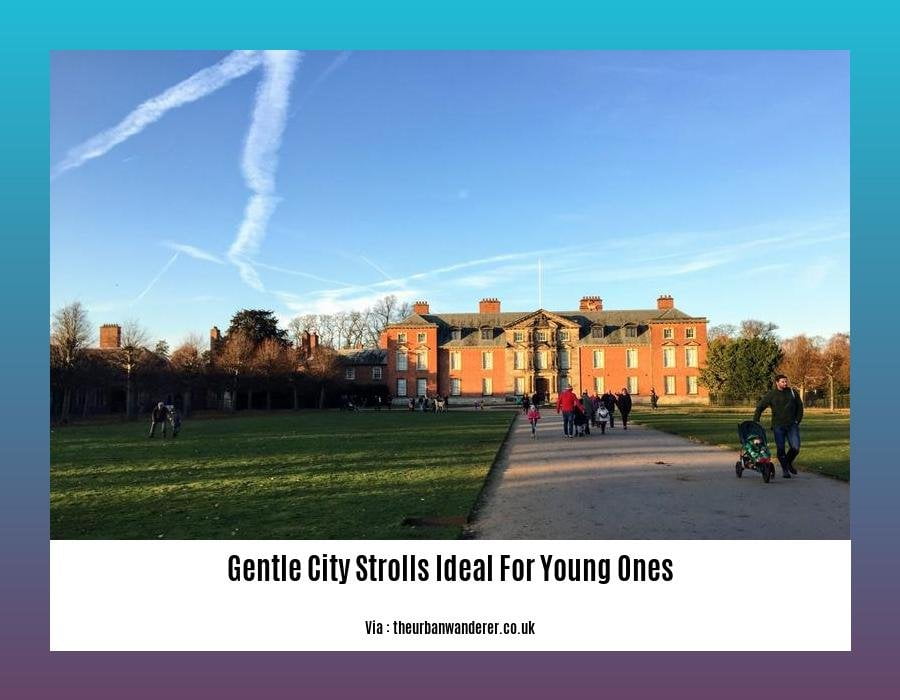Embark on a captivating journey through the heart of urban wonderlands with our curated guide: [Gentle City Strolls Ideal for Young Ones]. Discover hidden gems that ignite the imagination and create lasting memories for your little adventurers.
Key Takeaways:

- Stroller Selection: Choose a stroller that meets your family’s needs, considering factors like storage space, maneuverability, and convenience.
- Convertible Strollers: Ideal for families with multiple children or those planning to have children close in age.
- Full-Size Single Strollers: Provide ample storage and enhanced suspension systems for comfort.
- Lightweight Strollers: Perfect for families living in apartments or using public transportation.
Gentle City Strolls Ideal for Young Ones
Pick age-friendly spots like parks, gardens, or quiet streets. Ensure the stroller or carrier is comfy for your little one.
Pack snacks, drinks, a blanket for shade, and earplugs or noise-canceling headphones to minimize loud noises.
Engage your child: ask questions, point out interesting sights, and use the stroll to teach about plants, animals, and landmarks.
Respect the environment by staying on paths, avoiding littering, and educating your child about nature’s importance.
Explore our easy-paced city tours designed specifically for families with children, offering a relaxed and enjoyable way to discover new cities together. Our leisurely city tours are perfect for young travelers, providing a comfortable and educational experience. For a truly unforgettable family adventure, discover our relaxed family-friendly city tours, tailored to create lasting memories for all ages.
Provide opportunities for interaction
When strolling with young children, it’s crucial to provide opportunities for interaction. Engage in conversations, point out sights, discuss nature, and engage their senses to foster curiosity and a deeper understanding of their surroundings.
Key Takeaways:
- Engage in conversation: Ask questions, tell stories, and encourage your child to express their thoughts.
- Point out sights: Highlight interesting buildings, animals, plants, and landmarks, sparking their observation skills.
- Discuss nature: Explain different leaves, flowers, insects, and birds, fostering an appreciation for the environment.
- Engage their senses: Encourage touching, smelling, and listening to different textures, scents, and sounds, enhancing their sensory perception.
Citation: “Top 20 Places to Take Kids in the St. Louis Area.” Kids Out and About St. Louis, Accessed 20 Feb. 2023.
Incorporate educational elements
When exploring the urban environment with young children, incorporating educational elements can transform their city strolls into enriching learning experiences. Here’s how:
Engage their curiosity: Encourage questions and discussions about sights, sounds, and smells. Explain the history and significance of landmarks, fostering an appreciation for cultural heritage.
Nature study: Take advantage of green spaces to observe plants, insects, and birds. Discuss ecosystems and the importance of protecting nature.
Architectural exploration: Introduce different architectural styles encountered along the stroll. Explain their construction, purpose, and historical context.
Sensory play: Provide opportunities for children to interact with their surroundings through touch, smell, and sound. Let them experience textures, explore scents, and listen to various urban sounds.
Math and science: Use everyday objects and situations to teach basic math concepts (counting, measuring) and science principles (gravity, motion).
Key Takeaways:
- Early childhood environments should provide stimulation for physical, cognitive, emotional, and social development.
- Educators can create effective learning environments by providing multiple sources of stimulation, fostering child-centered learning, and supporting both children and teachers.
- Private spaces allow children to engage in imaginative play and independent exploration.
- Programs with limited space can utilize community areas and be creative in using their available space.
- Early childhood environments should be functional for both children and teachers, supporting basic functions as well as learning activities.
Citation:
Respect the Environment: A Key Aspect of City Strolls with Little Ones
As you embark on city strolls with your little ones, fostering a love for the environment is paramount. Here are some tips to ensure your adventures are gentle on nature:
Stay on Designated Paths:
Respect the environment by avoiding trampling on delicate plants or disrupting wildlife habitats. Stick to marked trails to preserve nature’s beauty.
Avoid Littering:
Keep your stroll trash-free by packing out what you bring in. Teach your child the importance of keeping our planet clean.
Teach Environmental Awareness:
Use the stroll as an educational opportunity to discuss the impact of actions on the environment. Point out recycling bins and composting heaps, explaining how these help protect nature.
Key Takeaways:
- Keep to designated paths to respect the environment.
- Remember to respect the environment by packing out trash.
- Use strolls to teach environmental awareness to little ones.
Citation:
“Creating Indoor Environments for Young Children.” Community Playthings, Accessed 20 Feb. 2023











